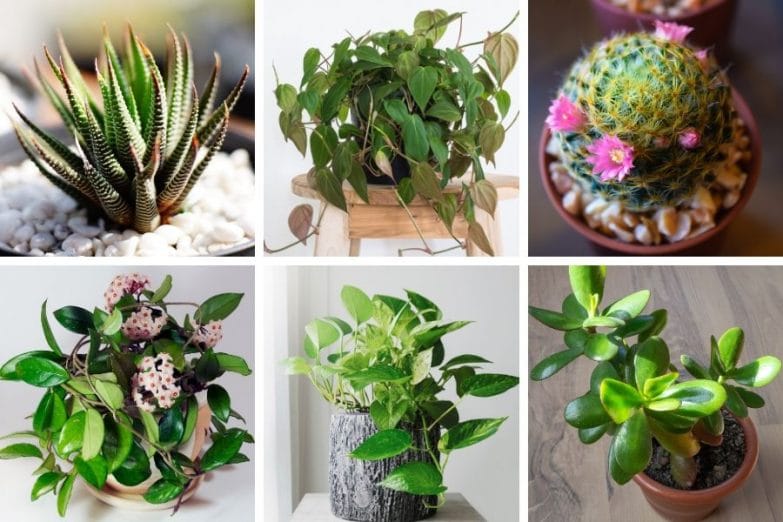If you’re a beginner gardener, have a brown thumb, or seem to always forget to water your plants, you should consider one of these hard to kill houseplants. These plants are not only beautiful and interesting, but are easy to care for, hardy, and will tolerant a bit of neglect. Here are 25 hard to kill houseplants for you to grow and enjoy.
What Are The Features Of Hard To Kill Houseplants?
If you’re looking for easy-care, hard to kill houseplants, look for some of these characteristics:
- Thrives in low-light or indirect light
- Loves standard household humidity and temperature
- Grows well in typical potting soil or succulent soil
- Will survive periods of neglect
Hard To Kill Houseplants
1. Pothos (Epipremnum aureum)
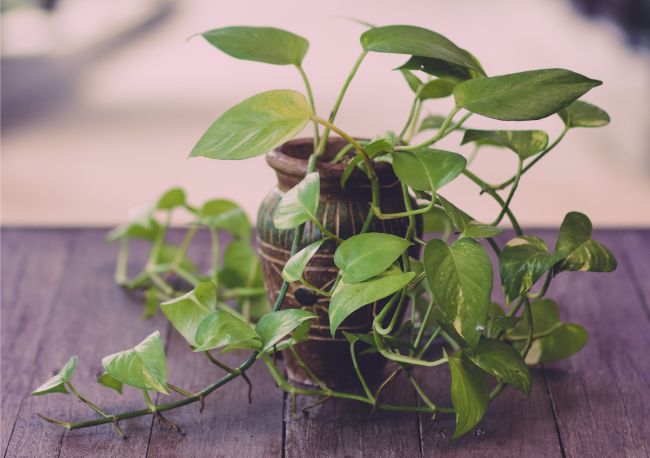
Pothos is also known as devil’s vine, devil’s ivy, and golden pothos. It is probably the easiest of all houseplants to take care of. It is a trailing plant with heart-shaped leaves. Sometimes pothos plants are variegated with yellow, white, and green.
Pothos thrives in indirect light but it can also grow in very low light and even artificial light. These plants are happy in ordinary potting soil. When watering, allow the soil to dry out completely before you water it again – this is good news for those who forget to water their plants! They’ll be just fine in typical household temperatures, too.
Healthy vines can grow up to the thirty feet long, but you can trim them back to whatever length you like without hurting the plant. Pothos are toxic to cats and dogs, but usually this is not a problem if they are kept as a hanging plant. These plants are easily propagated by putting cuttings in water until they grow roots.
Read my article about how to grow an impressive pothos in no time.
2. Snake Plant (Sansevieria trifasciata)
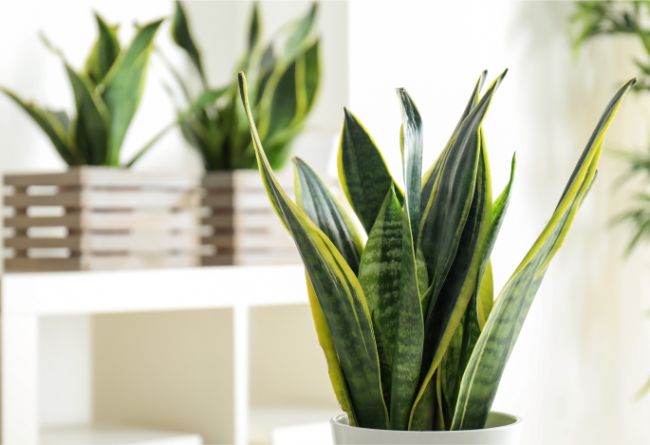
Snake plants thrive on neglect. These beautiful plants, also known as mother in laws tongue, have tall, stiff leaves of dark green. Some varieties are variegated and have yellow stripes that run down along the edges of the leaves.
You and your snake plant probably won’t even notice if you forget to water it for a few weeks. As a matter of fact, this plant does better when the soil dries out completely in between waterings.
When you do water it, just give it a long, deep drink, and then allow the water to drain out completely. Another wonderful quality to this plant is that it thrives in low light. It will grow fine in an office under fluorescent lights or other indirect lighting.
Read my snake plant care article for more info, or my article about common snake plant care problems so can grow this fantastic plant worry-free.
3. Spider Plant (Chlorophytum comosum)
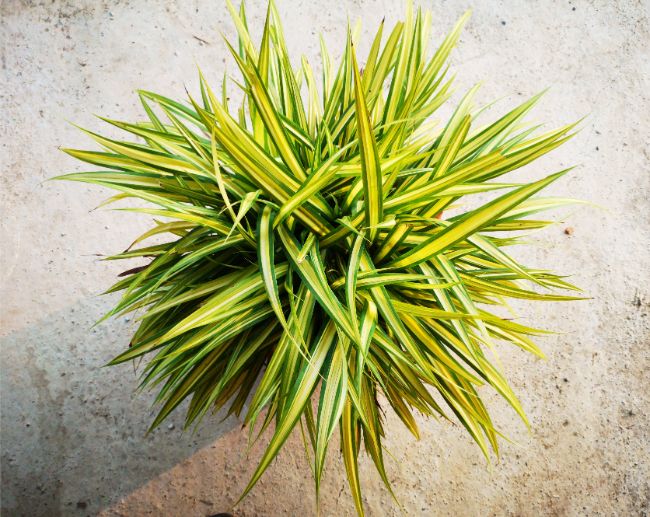
This popular houseplant is easy to care for and highly adaptable. They are typically available in a light green or variegated green and white color. Spider plants are named for the little clumps of small plants that hang off the end of its runners. These little spiderettes can easily be propagated into new plants.
These plants are so easy to care for: they enjoy being potbound, so you won’t need to repot them often. They thrive in bright indirect light, such as near a kitchen or bathroom window. They don’t need watered often but do give them a good drink when the soil begins to dry out.
As long as you don’t let them get too soggy, your spider plant will thrive. Spider plants have very few diseases or pests, and only occasionally suffer from brown tips on the leaves.
4. Aloe Vera (Aloe barbadensis)
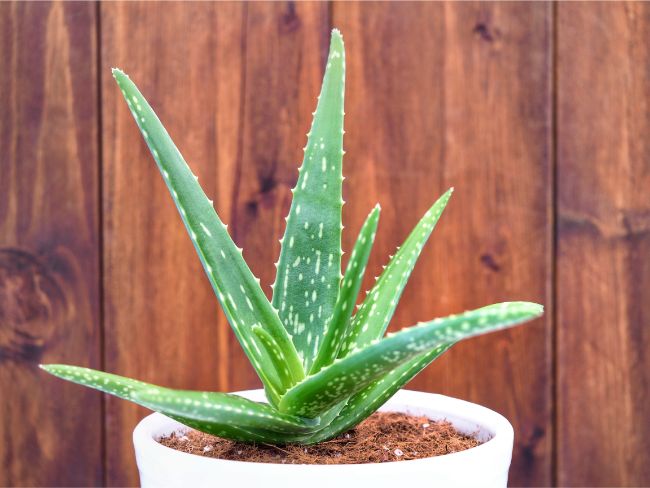
This succulent is beautiful and easy to grow. Aloe plants grow from a center cluster, sending out tall stiff leaves filled with gel. This gel has numerous beauty and health uses.Some varieties have small but not sharp spikes along the edges of the leaves.
Aloe plants grow best in a succulent potting soil, or a rich potting soil mixed with vermiculite to improve drainage. Aloes like a nice long drink, but then allow the water to drain completely away from the soil. Do not water again until the soil is dry.
The easiest way to kill an aloe plant is to overwater it, but if you err on the side of underwatering it, your plant will thrive. Aloe vera plants like bright indirect light, so keep them in a sunny window.
5. Madagascar Dragon Tree (Dracaena marginata)
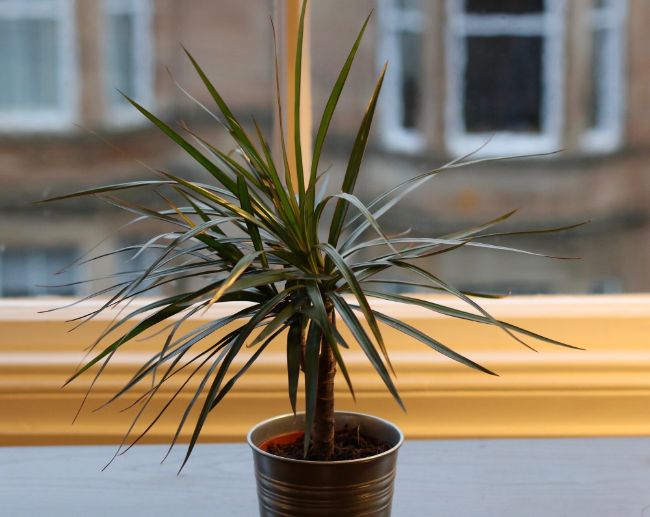
These striking plants with vivid colors are easy for beginners to grow and enjoy. They can grow up to 20 feet in their outdoor environment, but inside, can be grown from one to six feet in height by potting and pruning appropriately.
Madagascar dragon tree can tolerate a wide range of temperatures. They grow best in bright indirect light, but will tolerate lower levels of light as well , they might just lose some of their color.
Keep dracaenas in rich, well-draining soil and only water when the top half of the soil is dry. These trees need large pots for their extensive root systems. They have very little need for fertilizing or extra humidity. This plant is not harmful to humans but might be toxic to cats and dogs.
Read my Madagascar dragon tree care article for all you need to know about growing these beautiful hard-to-kill houseplants.
6. Chinese Evergreen (Aglaonema sp.)
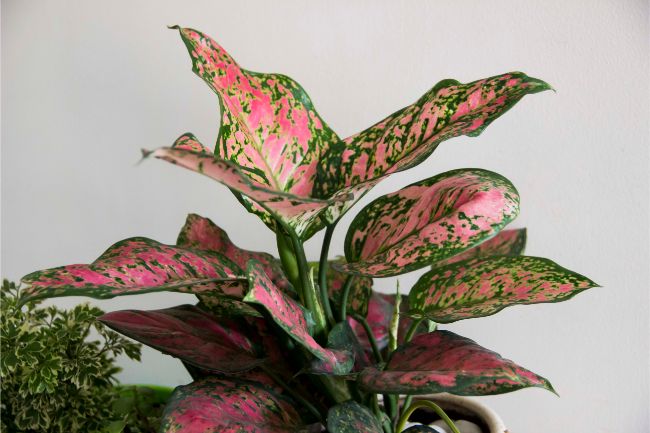
For the haphazard plant-lover you cannot beat a Chinese evergreen. This plant is both beautiful and sturdy, showing off pretty green leaves mottled with silver.
Small young plants can sit on your desk, but older larger plants will make a nice corner piece in your room on the floor. These plants are slow growing, so there’s no rush to repot it.
You can’t go wrong with your Chinese evergreen. It likes bright light but it does equally well in low lights and even artificial light. You can keep the soil evenly moist, or let it dry out for a week or two before you water it again. You don’t need to fertilize it, but you can if you like. If you have trouble remembering to take care of your plants regularly, this is the plant for you.
7. Flaming Katy (Kalanchoe blossfeldiana)
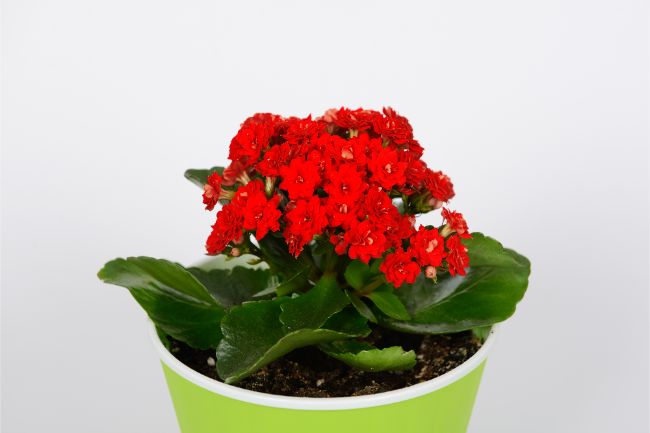
The flaming katy, or kalanchoe, thrives on neglect. These hard to kill houseplants are often found for sale at your local grocery store in shades of red, white, yellow, orange, and pink. Large heads of small tubular flowers pop out of deep green, fleshy leaves. These striking plants are pretty and easy to handle.
This plant only needs to be watered when the soil dries out – it may go as long as two weeks without being watered. Kalanchoes do best with bright sunlight, so a sunny windowsill is ideal.
You can deadhead your plant to keep it flowering longer. If your flaming katy stops blooming, you don’t have to throw it away. Just simulate 14 hours of darkness each night and in about a month or two, you’ll see buds begin to appear again. Read more about caring for flaming katy in this article.
8. Rubber Plant (Ficus elastica)
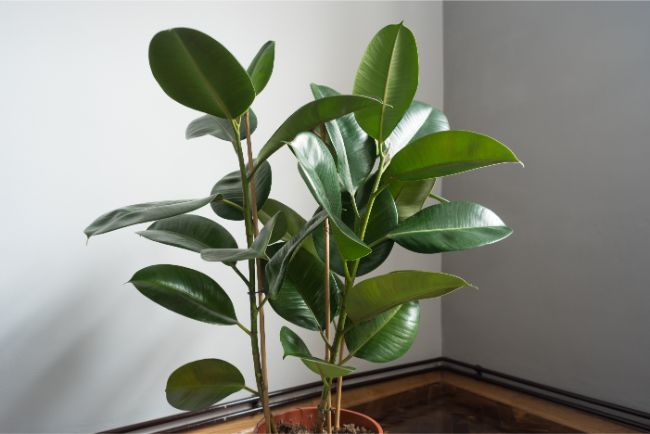
If you’re looking for hard to kill houseplants, you can’t go wrong with a rubber plant. Even though it has been labelled a plant, in the wild, the ficus elastica can grow sixty to eighty feet tall.
In your home, under the right conditions, the rubber plant can grow pretty fast, so even if you purchase a small plant, you’ll get a lot of plant potential for your money. These plants come in many varieties, from dark, rubbery green leaves to pale variegated varieties.
Rubber plants do need lots of indirect light to grow. You should keep the soil a little damp but definitely not soggy. If the leaves look dusty, you can wipe them off with a soft damp cloth. Other than that, you’ll need to repot your rubber plant every so often as it grows. Choose a heavy pot with well-draining potting soil. Read more about rubber plant care in this article.
9. Bromeliads (Bromeliaceae)
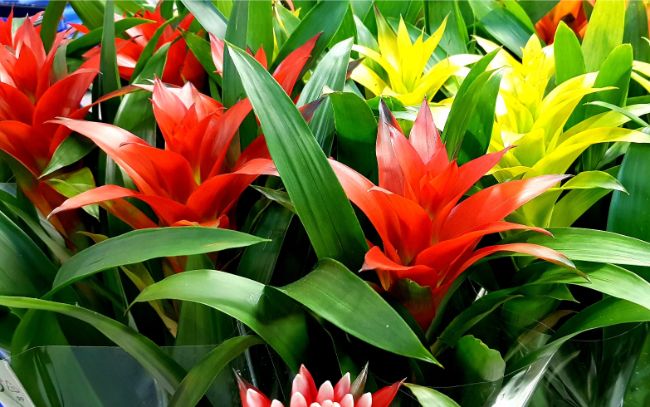
Bromeliads are dazzling houseplants that come in a striking array of colors. Once thought to be difficult to care for, now you really can incorporate these beauties easily into your home.
Bromeliads can tolerate wide ranges in temperature, so you don’t need to be too fussy about the temps when you keep one in your home. However, when the temperatures get hot, you’ll need to increase the humidity around the plant. The easiest way to do this is put the pot in a pebble tray and fill the pebble tray with water.
These striking plants have a variety of light needs, so make sure you follow the specifics for the variety of bromeliad you have. In general, bright indirect light will make your bromeliads happy.
The most critical part of bromeliad care is the soil and water. Use a fast-draining soil. Water thoroughly and make sure you allow all of the water to drain out. Allow the soil to dry out completely before watering again. Once your bromeliad’s bloom dies, it may be difficult to get it to bloom again.
10. Jade Plant (Crassula ovata)
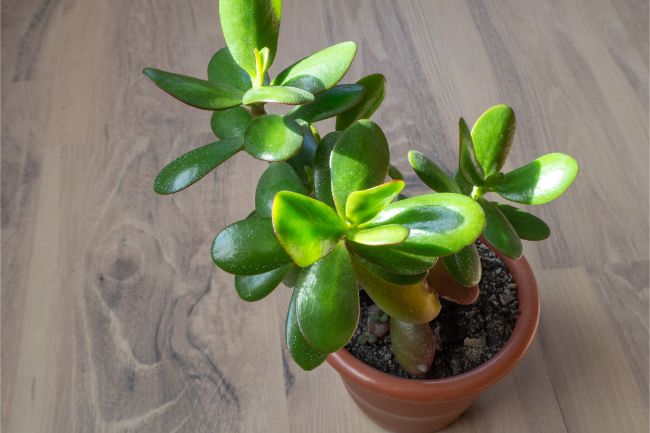
Jade plants are intriguing, long-lived succulents that represent money and good luck. You’ll recognize them by their thick woody stems and pretty oval green leaves. They require very little care to thrive.
It’s ok to underwater your jade plant. You’ll know it is overdue for a drink when its leaves begin to shrink. Then give it a long, slow drink of water, allowing the water to completely drain out of the soil. Don’t water again until the top of the soil has dried out. In the winter, when growth is slow, you can let it go a little longer.
Jade plants need bright direct sun for a few hours a day, but the variegated varieties can get by with just indirect light. You won’t need to replant your jade very often; they prefer being rootbound and this will help control their size.
I’ve written many articles about jade plants on this site. If you’d like to learn more, why not start with my jade plant care article.
11. Zebra Haworthia (Haworthiopsis fasciata)
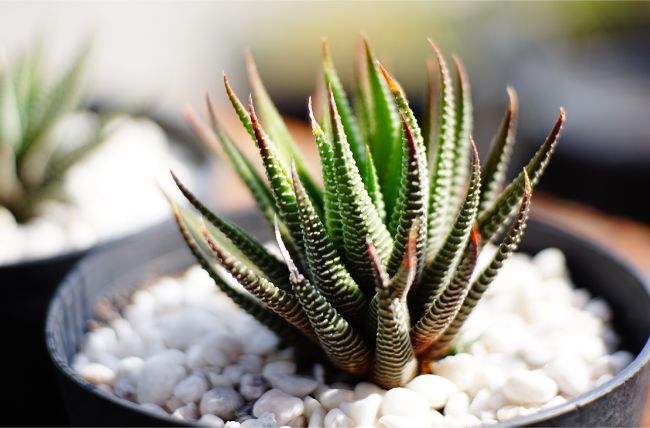
Zebra haworthia is a smaller, rosette shaped succulent. These little plants are as easy to grow as aloe or other succulents. Their unfussy nature and pretty pearlish stripes make them a great beginner plant.
The zebra cactus grows best in bright, indirect light. Plant it in a succulent or cactus mix potting soil. Make sure your pot or planter has good drainage. Water your haworthia thoroughly in the spring and summer, allowing the water to drain out. In the winter, you only need to water it every other month or so. They are slow growing and genuinely hard to kill houseplants.
12. Ponytail Palm (Beaucarnea recurvata)
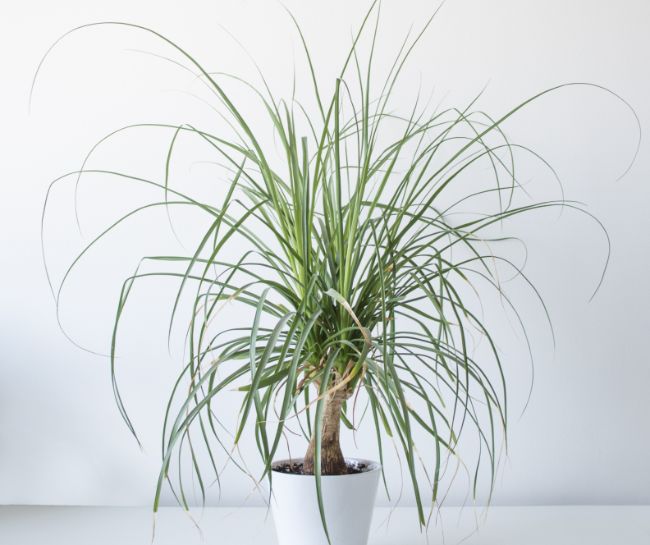
This is a visually interesting houseplant that will thrive if you don’t overwater it. It isn’t truly a palm but grows a large bulbous base with long leafy streamers piling out of the top. These special plants can grow up to 30 feet tall in their native habitat, but indoors rarely reach heights more than four feet.
Plant your ponytail palm in cacti and succulent potting mix, or make your own with equal parts potting soil, sand, and perlite. Use a pot with good drainage. Keep the soil fairly dry, draining off any excess water when you do water it. Water sparingly during winter months.
If you keep your ponytail palm in a smallish pot, the growth will be restricted. If you want a larger plant, put it in a larger pot where it has room to grow.
Read more about ponytail palm care in this article to get fully up to speed with looking after this wonderful plant.
13. Phalaenopsis Orchid (Phalaenopsis spp.)
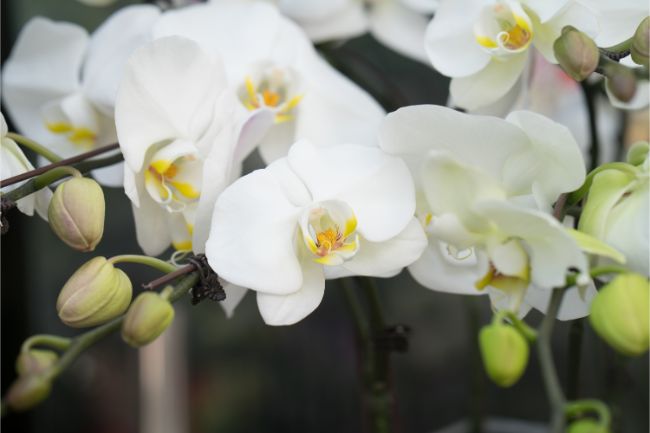
The moth orchid, or phalaenopsis, is harder to kill than its delicate appearance would imply. These beautiful, spritely orchids will offer you gorgeous blooms with very little effort.
Moth orchids prefer bright indirect light. Keep them out of the direct sun so they don’t get scorched. Bark potting medium is all that they need, and just enough to give some structure to the roots so they don’t become top heavy. Water the plant once the potting medium has dried and the roots have turned from green to silver in appearance.
To prevent the stem from rotting, don’t let water sit around the base of the plant. Reduce watering in the winter. These plants like slightly warmer homes and may need a pebble tray underneath to add humidity.
One of my favorite indoor plants of any type. Long-lasting, stunningly beautiful blooms and much easier to care for than you would think. I’ve written loads of articles about phalaenopsis orchids on this site. Read my beginner’s guide to get started.
14. ZZ Plant (Zamioculcas zamiifolia)
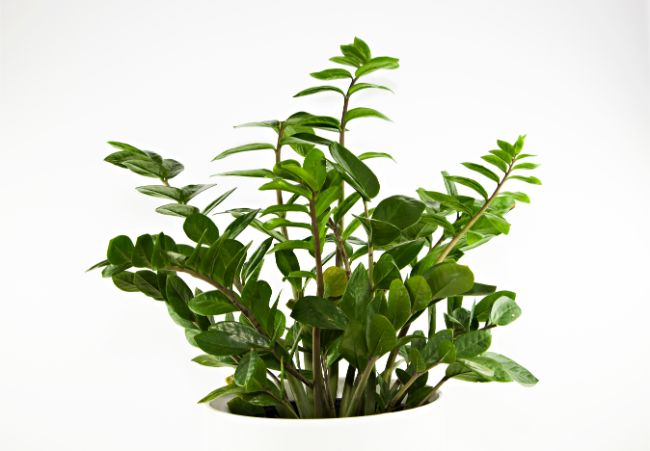
If you are looking for hard to kill houseplants, you’ve just found one of the best. A ZZ plant can thrive under the most serious neglect. This shrubby plant with bright green leaves grows to about two or three feet tall, and equally as wide. It isn’t super fussy and will do fine under a variety of conditions.
You can keep your zz plant in low light to bright indirect light. It will grow just fine in an office building, too, under the fluorescent lights. It isn’t too particular about its dirt – just keep it in some regular potting soil.
Only water it when the soil is dry. It’s pretty forgiving if you skip a watering or two, so don’t stress if you forget. If it gets too big, cut it back a bit and it won’t even care.
One word of caution, the ZZ plant is toxic. Don’t let your children or animals eat it and wash off any sap right away as it may cause skin irritation.
15. Christmas Cactus (Schlumbergera)
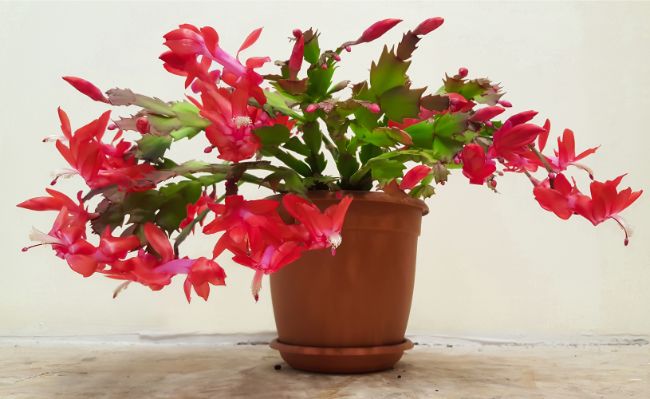
Christmas cacti make beautiful holiday gifts for a reason – they are easy to care for and brighten any space with their gorgeous long-lasting blooms.
You’ll want to keep them in a pot with good drainage holes and well-draining potting soil. When the soil feels dry, give your cactus a long thorough soaking, then let the water drain out. They love bright, indirect light. Just like your home, they like it a little warmer in the day (around 70°F/21°C) and a little cooler at night (around 65°F/18°C).
To convince your Christmas cactus to bloom again the following year, you need to give it six weeks of 14 hour nights of darkness and temperatures around 50 to 55°F. This should convince your Christmas cactus to bloom all over again. Don’t feel guilty about buying a new plant each year, as getting them to rebloom takes a little bit of effort.
16. Umbrella Tree (Schefflera)
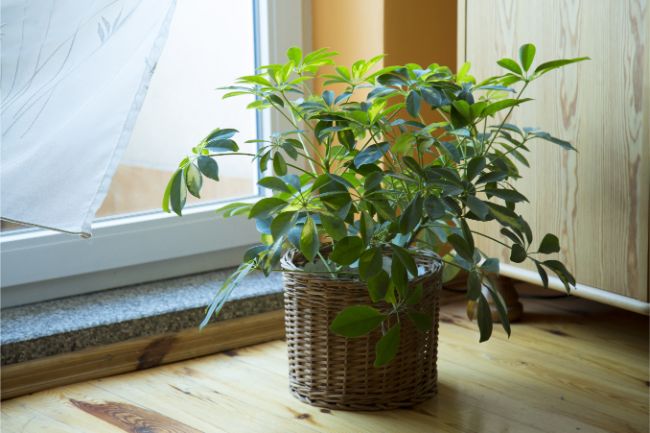
This beautiful tree will grace your space without stealing too much precious time. The Umbrella tree gets its name from the umbrella shaped tiers of glossy leaves. There are two types of umbrella tree, Schefflera arboricola and Schefflera actinophylla, but both are very similar and the growing conditions needed are almost identical.
Umbrella trees do well in bright, indirect light. Lower light conditions will slow growth, and the tree may become somewhat leggy, but you can pinch or prune them back to improve the problem. They are happy at about the same temperatures as people, so they will be comfortable in your home.
Use a pot and soil with good drainage and water thoroughly, but don’t let the plant sit in water. The leaves and sap are toxic to animals and people, so keep an eye on your cats, dogs, and small children around any umbrella tree.
17. Cast Iron Plant (Aspidistra elatior)
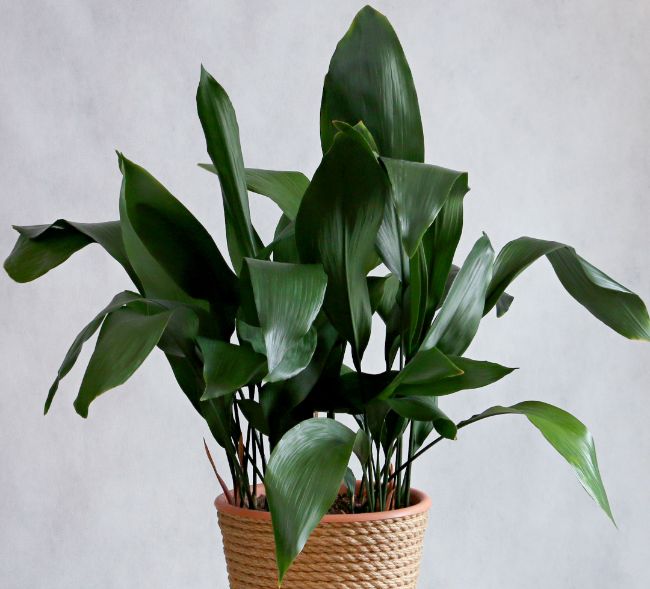
This lush, leafy green plant makes a fuss-free houseplant and it is as tough and hardy as its name suggests. Like most houseplants, it prefers a well-draining potting mix. It can grow in dim light to bright indirect light, just keep it out of the direct sun.
During the spring and summer growing season, keep the soil evenly moist but not soggy. In the winter months when growth is slowed, you can water less. They are dependable plants for even the most black-thumbed gardener and will grow small purple blossoms hidden deep in the foliage. They are safe for cats and dogs.
One of the most low maintenance, hard to kill houseplants you can grow and highly recommended to fill lower light locations in your home. I’ve been growing a cast iron plant in my hall for years now, and even with lower light conditions, it still looks great. Read my article about cast iron plant care to learn more.
18. Peace Lily (Spathiphyllum sp.)
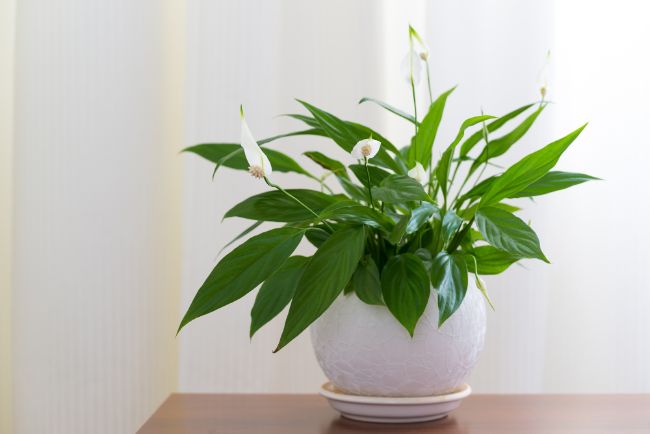
It’s not surprising that peace lilies are one of the most common and beloved houseplants. They are low maintenance and easy to grow, even for beginners. These pretty plants come in a variety of sizes, from table top size to four-foot versions that can easily dominate a room. They are marked by their deep green plumage and striking white flowers resembling peace flags.
Caring for your peace lily is so simple. Peace lilies are happy growing indoors, and bright indirect light will keep them growing. You’ll know they aren’t getting enough light if they aren’t blooming.
They like a well-draining potting soil mix that is kept evenly moist. You may need to increase the humidity a bit around your peace lily, which you can simply by using a pebble tray with water under the plant. They don’t do well in frigid temps, but the warmth of your home should be just right. If the leaves get dusty, just wipe them off with a damp cloth.
19. Hindu Rope Plant (Hoya carnosa compacta)
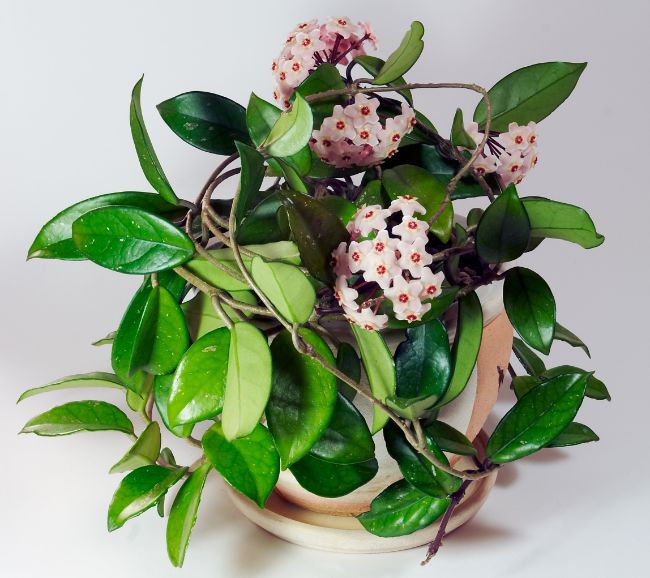
This unique plant looks exotic with its twisting, rope-like vines, but it is tough, adaptable, and not too fussy. These hard to kill houseplants can survive a bit of neglect, so will probably be just fine when life gets busy and you forget to give it a drink.
To encourage your rope plant to bloom, place it in a window that gets direct morning sun and lots of indirect light. It will be happy in any well-draining potting mix and won’t expect too much in the way of fertilizer.
They will tolerate dry soil, but in the summer, give your rope plant long, deep waterings. Let the top of the soil dry out before watering again. In the winter, the plant will go dormant and require less water. Learn more about hoya carnosa in this article.
20. Purple Shamrock (Oxalis triangularis)
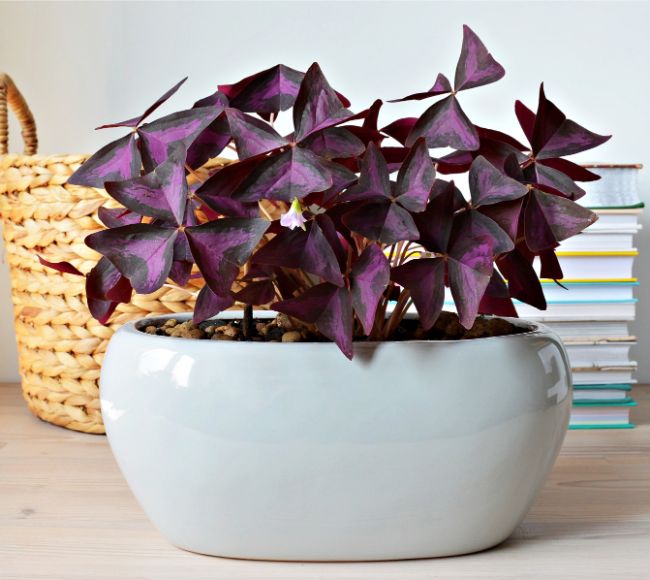
Purple shamrock or false shamrock are a deep, purpled-hued plant graced with white flowers and resembling a shamrock or three leaf clover. This beautiful house plant looks delicate but is surprisingly sturdy. The photophilic plant opens and closes its flowers and leaves in response to light and darkness, making it a magical, mystical plant to enjoy.
Plant your oxalis triangularis in a standard, rich potting soil that drains well. You may need to add a little perlite to get the mix right. It likes bright, indoor light, so keep it near a sunny window. This plant will be happy at temperatures that keep your home comfortable, somewhere between 60-75°F.
Water your plant when the top inch of soil feels dry and make it sure the water drains away. In the winter, when the plant goes dormant and isn’t actively growing, you only need to water it every two to three weeks. These plants are easy to grow from bulbs in a matter of weeks. Read this article about how I grew purple shamrocks from bulb in only five weeks.
21. Kaffir Lily (Clivia miniata)
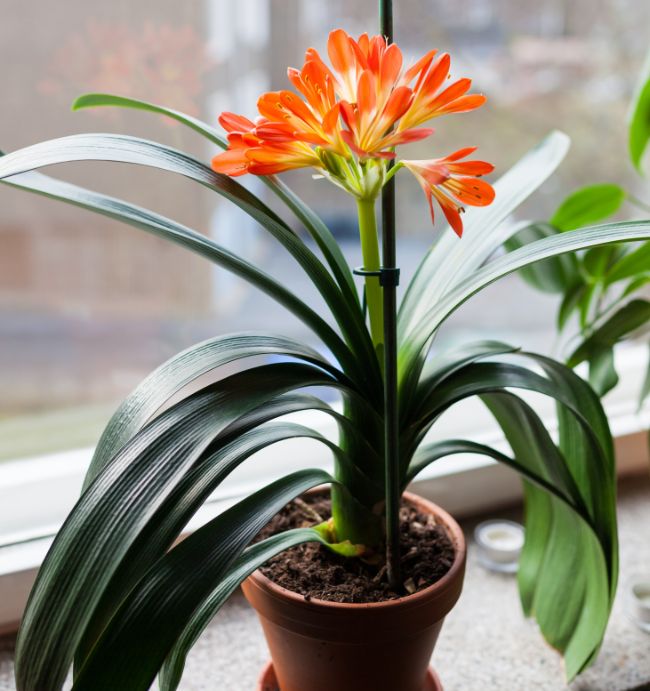
Clivia plants are relatives to amaryllis and are nearly indestructible, hard to kill houseplants. Known for their bright yellow, orange, or cream-colored, trumpet shaped blooms, these beautiful plants will certainly be a conversation piece in your home.
Grow your clivias in a rich, well-draining potting mix in a deep pot. Allow the soil to dry out a bit between deep waterings and keep them in bright, indirect light. In the fall, if your plant has stopped blooming, allow it to have a bit of a dry rest period so they can start blooming again in late winter. You won’t need to repot your clivia often because they bloom better when they are rootbound.
22. Flamingo Flower (Anthurium Sp.)
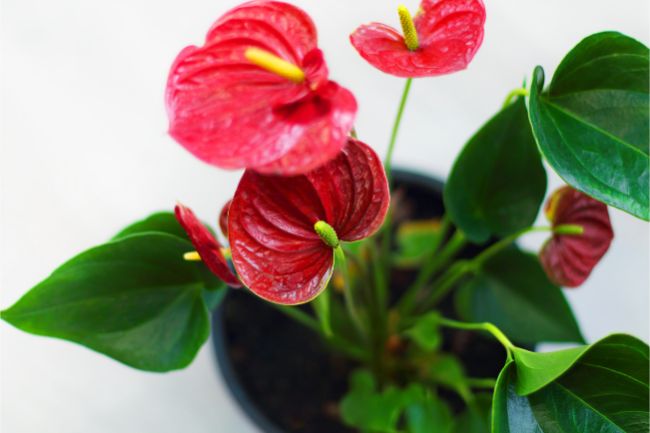
Anthuriums are known for their gorgeous foliage and heart-shaped, bright red blooms. It doesn’t take much to grow these hard to kill houseplants and you’ll be rewarded with beautiful blooms.
Grow your anthuriums in a mix of 1 part potting soil to 1 part perlite so that it drains freely but can stay a bit moist. Water the plant only when the soil becomes dry to the touch. Anthuriums cannot tolerate direct sun, but medium to bright indirect light will keep them more than satisfied. You may need to move your plant around a bit to find the spot that keeps it happiest and blooming.
Read more about Flamingo Flower care in this article.
23. Parlor Palm (Chamaedorea elegans)
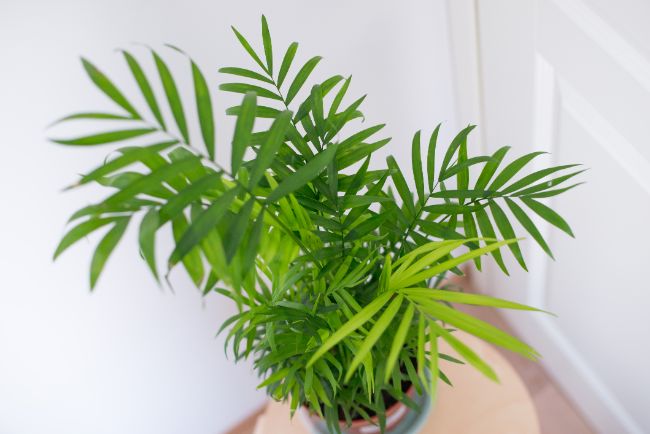
The parlor palm is a small palm tree native to Mexico. The palms are usually grown in small clumps in pots, making for an attractive display. They are often potted alongside other houseplants for contrast.
While these little palms prefer bright, filtered light, they can do well in lower light situations. Plant your palms in pretty much any high-quality potting soil. They don’t like being overwatered, so only water when the top inch of the soil is starting to get dry. Keep these hard-to-kill houseplants out of the cold and away from drafts and they will be happy. Read my guide on parlor palm care to learn more.
24. Cactus (Cactaceae)
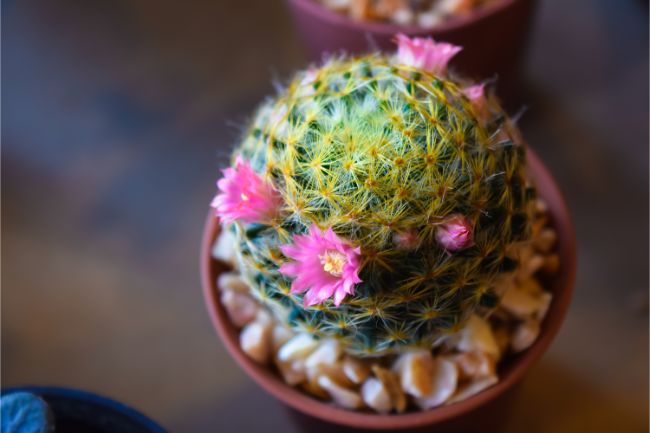
Quite possibly the easiest of all houseplants is the cactus. Available in all kinds of shapes, sizes, and colors, the possibilities are pretty endless and the required care is very basic. Cacti such as angel wings, saguaro cactus, barrel cactus, Old Lady Cactus, and Bishop Cactus offer interesting shapes and texture, and occasionally, some pretty blooms.
Caring for cacti is simple. Generally, they like dry warm conditions, such as any typical household environment, bright light, and to be watered twice a month.
25. Philodendrons (Philodendron Sp.)
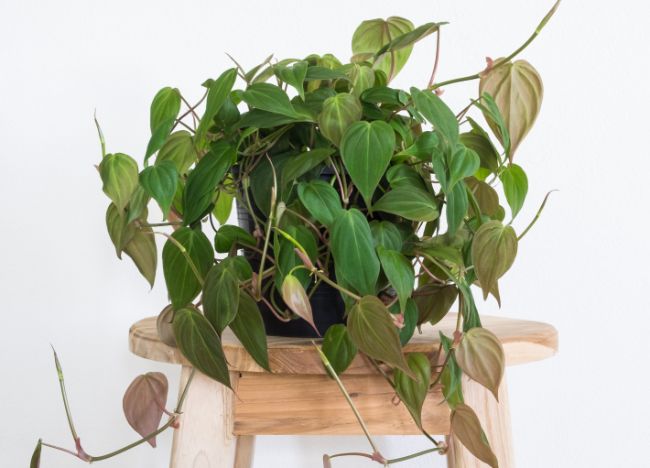
A mainstay of indoor gardening, the philodendrons are generally easy to care for and highly adaptable to your home. There are two types – vining and non-climbing. To care for your philodendron, keep it in a location that gets bright, indirect sunlight. If the sun’s rays hit the plant directly, it could burn and turn yellow. But don’t fuss too much – they can tolerate pretty low levels of light, too.
Water them only when the top inch of soil gets dry. Your philodendron won’t mind if you forget to water it once in a while, just don’t let it sit in soggy soil. To give it a boost, apply a commercial houseplant fertilizer once a month in the spring and summer, and every other month in the fall and winter.
One of my favorites is the heartleaf philodendron. If you’re looking for hard to kill houseplants, it is a great option that will fill your home with greenery. I’ve written more about heartleaf philodendron here.

